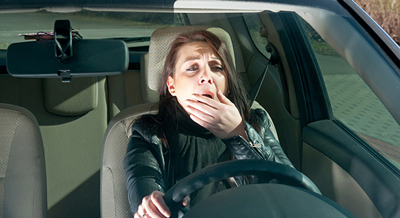It’s something that most drivers experience but may not realize until it’s too late---feeling drowsy---which plays an underappreciated role in traffic crashes, injuries and deaths.
Although underreported in government statistics, previous research by the AAA Foundation for Traffic Safety has estimated 16% to 21% of all police-reported fatal vehicle crashes likely involve drowsy driving. And now, new foundation research found drivers may underestimate their drowsiness, leading them to stay behind the wheel instead of stopping for a much-needed break.
“Being drowsy while driving is a dangerous form of impairment, and it does not resolve or improve with continued driving,” said Dr. David Yang, the foundation’s president and executive director. “Our goal is to help drivers learn to heed the early warning signs of drowsiness so they can stop, rest and then continue their journey as safely as possible.”
Drowsiness refers to a state of increased tendency to fall asleep. Beyond the danger of falling asleep at the wheel, drowsiness also impairs drivers by reducing their alertness. Crashes caused by drowsy driving tend to be severe because the driver may not attempt to brake or swerve to avoid a collision, so the resulting impact occurs at a high rate of speed. A drowsy driver may also be startled and lose control of the vehicle.
Researchers designed a 150-mile simulated nighttime highway driving experiment for the study. Every 20 miles, there was a simulated “rest area” at which participants could stop, leave the driving simulator, walk around, nap, drink coffee or eat a snack. A monetary incentive encouraged drivers to complete the drive as quickly as possible while incentivizing them to avoid crashing. Researchers used a brief survey to gauge how drowsy drivers felt and measured the percentage of time their eyes were closed to gauge sleepiness.
Key Findings
Levels of drowsiness generally increased throughout the simulated highway driving experiment. Participants were usually aware they were drowsy, but their perceptions of the extent of their sleepiness were not always accurate and affected decision-making.
When drivers rated their level of drowsiness as low, 75% of them were, in fact, moderately or severely drowsy.
Even when drivers’ eyes were closed for 15 seconds or longer over a one-minute window---indicative of severe drowsiness---one in four still rated their drowsiness as low.
Drivers very rarely took breaks unless they perceived that they were very drowsy.
Even when drivers recognized they were extremely drowsy, they still declined 75% of their opportunities to take breaks and kept driving.
The results demonstrate a need to help drivers recognize how drowsy they are. Knowing the warning signs of drowsiness can help drivers avoid dozing off behind the wheel. The most common symptoms include having trouble keeping your eyes open, drifting from your lane and not remembering the last few miles driven.
While the signs of drowsiness should never be ignored, drivers must not wait for their bodies to sound the alarm. They should prioritize sleeping at least seven hours before hitting the road.
AAA recommends drivers travel at times of the day when they are normally awake, avoid heavy foods and avoid medications that cause drowsiness or other impairment.
For longer trips, drivers should schedule a break every two hours or every 100 miles, travel with an alert passenger and take turns driving and not underestimate the power of a quick nap. Pulling into a rest stop and taking a quick catnap---at least 20 minutes and no more than 30 minutes of sleep---can help to keep you alert on the road.
AAA supports the development of vehicle technology that can passively monitor drivers for impairment and prevent or limit vehicle operation when needed. The 2021 Infrastructure Investment and Jobs Act requires NHTSA to create testing standards for this kind of technology that can detect driver impairment, including that caused by drowsiness, medical impairment or drugs, including alcohol.
Source: AAA










